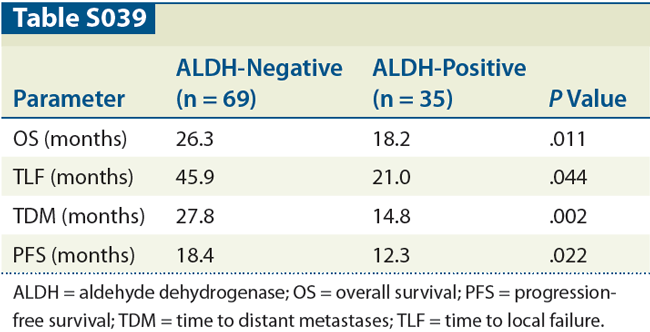(S039) ALDH-Expressing Cancer Stem Cells Are Associated With Inferior Survival in Patients With Resected Pancreatic Adenocarcinoma Treated With Adjuvant Chemoradiation
In this study, we investigate the role of ALDH expression in predicting survival and patterns of disease recurrence in pancreatic adenocarcinoma patients treated with chemoradiation following pancreatectomy.

Rachit Kumar, MD, Avani Dholakia, BS, Joseph Herman, MD, MS, Anirban Maitra, MD, Seung-Mo Hong, MD, William Matsui, MD, Christopher Wolfgang, MD, PhD, Dan Laheru, MD, Christine Iacobuzio-Donohue, MD, PhD, Zeshaan Rasheed, MD, PhD; Department of Radiation Oncology and Molecular Radiation Sciences, The Johns Hopkins University
Introduction: We and others previously identified aldehyde dehydrogenase (ALDH) activity as a marker of pancreatic cancer stem cells (or tumor-initiating cells). The presence of cancer stem cells (CSCs) has been associated with decreased survival and treatment resistance in pancreatic adenocarcinoma. In this study, we investigate the role of ALDH expression in predicting survival and patterns of disease recurrence in patients treated with chemoradiation (CRT) following pancreatectomy.
Methods: Tissue microarrays using pancreatectomy specimens from 1998–2002 at our institution were made, stained for ALDH1, and scored as ALDH-positive or ALDH-negative by two expert pancreatic cancer pathologists blinded to patient outcomes. Physician documentation and radiology reports were used to document patient follow-up information. Time to local failure (TLF), time to distant metastases (TDM), progression-free survival (PFS), and overall survival (OS) were analyzed using SPSS software.
Results: Previously, we found that ALDH expression was associated with worse OS in a cohort of 269 patients with resected pancreatic adenocarcinoma (Rasheed, JNCI 2009). From this original cohort, adjuvant treatment information was available for 87 patients with ALDH-negative tumors (48.6%) and 41 patients with ALDH-positive tumors (45.6%). In patients treated with adjuvant CRT, median OS was superior in the ALDH-negative cohort versus the ALDH-positive cohort (26.3 mo vs 18.2 mo; P = .011). Further, in patients treated with adjuvant CRT, ALDH-negative patients had statistically greater TLF, TDM, and PFS than their ALDH-positive counterparts (see Table). On multivariate analysis, ALDH-positive tumor staining (hazard ratio [HR] = 1.94; P = .004) and tumor grade (HR = 1.54; P = .041) predicted lower OS, and ALDH-positive tumor staining (HR = 1.83; P = .008), tumor grade (HR = 1.52; P = .038), and tumor size > 3 cm (HR = 1.65; P = .023) predicted decreased PFS.
Discussion: This study suggests that adjuvant CRT improves TLF, TDM, PFS, and OS in patients with localized pancreatic adenocarcinoma that is not enriched with ALDH-expressing CSCs. We are in the process of studying ALDH expression as a biomarker for predicting response to chemoradiation in patients with locally advanced pancreatic adenocarcinoma. Laboratory studies will help elucidate the mechanisms of treatment resistance in ALDH-expressing CSCs.
Proceedings of the 96th Annual Meeting of the American Radium Society - americanradiumsociety.org